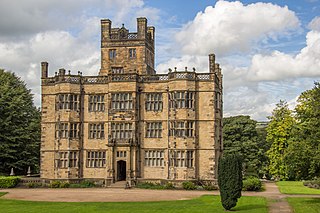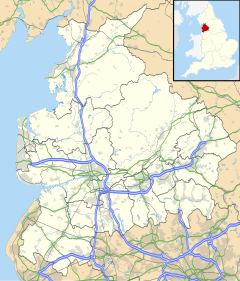
Gawthorpe Hall is an Elizabethan country house on the banks of the River Calder, in Ightenhill, a civil parish in the Borough of Burnley, Lancashire, England. Its estate extends into Padiham, with the Stockbridge Drive entrance situated there. The house is traditionally attributed to Robert Smythson. In the mid-19th century, the hall was rebuilt by Charles Barry, the architect of the Houses of Parliament. Since 1953 it has been designated a Grade I listed building. In 1970 the 4th Lord Shuttleworth gave the hall to the National Trust, with a 99-year lease to Lancashire County Council. Both bodies jointly administer the hall and in 2015 the council provided £500,000 funding for restoration work on the south and west sides of the house.

Cockersand Abbey is a former abbey and former civil parish near Cockerham in the City of Lancaster district of Lancashire, England. It is situated near the mouth of the River Cocker.

Lytham Hall is an 18th-century Georgian country house in Lytham, Lancashire, 1 mile (1.6 km) from the centre of the town, in 78 acres (32 ha) of wooded parkland. It is recorded in the National Heritage List for England as a designated Grade I listed building, the only one in the Borough of Fylde.
This is a list of Grade I listed buildings in Lancashire, England.
Read Hall and Park is a manor house with ornamental grounds of about 450 acres (180 ha) in Whalley Road, Read, a few miles west of Padiham, Lancashire, England.

Blackpool is a seaside town and unitary authority situated on The Fylde coast in Lancashire, England. This list includes the listed buildings in Blackpool and Bispham, a village within the borough of Blackpool. One is classified by English Heritage as being in Grade I and five in Grade II*. In the United Kingdom, the term "listed building" refers to a building or other structure officially designated as being of special architectural, historical or cultural significance. These buildings are in three grades: Grade I consists of buildings of outstanding architectural or historical interest; Grade II* includes particularly significant buildings of more than local interest; Grade II consists of buildings of special architectural or historical interest. Buildings in England are listed by the Secretary of State for Culture, Media and Sport on recommendations provided by English Heritage, which also determines the grading.

Old St John the Baptist's Church is a redundant Anglican church in the village of Pilling, Lancashire, England. It stands 160 yards (150 m) to the south of the new church, also dedicated to St John the Baptist. The church is "an unusual survival of a small Georgian church". It is recorded in the National Heritage List for England as a designated Grade II* listed building, and it is under the care of the Churches Conservation Trust.

Ashton Hall is a largely rebuilt 14th-century mansion in the civil parish of Thurnham, Lancashire, England. It is 3 miles (4.8 km) south of the city of Lancaster and is on the east bank of the River Lune. It is recorded in the National Heritage List for England as a Grade I listed building, and is now owned by Lancaster Golf Club.
Robert Roper (1757–1838) was an English architect who practised from an office in Preston, Lancashire. His works include at least two new country houses, Claughton Hall, and Leagram Hall, both of which have since been demolished. He designed at least two new churches, Holy Trinity, Hoghton, a Commissioners' church, and St John the Evangelist, Clifton. He rebuilt the naves of the churches of St Michael, Kirkham, and St John the Baptist, Broughton, and also added a façade to Thurnham Hall.

Thurnham Hall is a Grade I listed 17th-century country house in the village of Thurnham, Lancashire, England some 10 km south of Lancaster.
Accrington is a town in Hyndburn, Lancashire, England. It contains 43 listed buildings, which are designated by Historic England and recorded in the National Heritage List for England. Of these, two are listed at Grade II*, the middle grade, and the others are at Grade II.
Ellel is a civil parish in Lancaster, Lancashire, England. It contains 47 listed buildings that are recorded in the National Heritage List for England. Of these, one is listed at Grade II*, the middle grade, and the others are at Grade II. The parish contains the villages of Galgate and Dolphinholme, and is otherwise rural. A high proportion of the listed buildings are country houses, smaller houses and cottages, farmhouses and farm buildings. In the 18th and 19th centuries silk spinning took place in Galgate, and two silk mills, later converted for other uses, are listed. The Lancaster Canal passes through the parish, and the junction with its Glasson Branch is also in the parish. Associated with these are listed bridges, locks, and an aqueduct. Bridges over the Rivers Wyre and Conder are also listed. Other listed buildings include a public house, churches and structures in churchyards, a milestone, a war memorial. and boundary stones.
Morecambe is a seaside town in the City of Lancaster, Lancashire, England. It contains 43 buildings that are recorded in the National Heritage List for England as designated listed buildings. Of these, two are at Grade II*, the middle grade, and the others are at Grade II, the lowest grade. The town originated as a small fishing village called Poulton, and started to be used as a resort towards the end of the 18th century. It expanded during the 19th century, particularly following the arrival of the railway in 1850. The town was officially renamed Morecambe in 1889.
Thurnham is a civil parish in Lancaster, Lancashire, England. It contains 37 listed buildings that are recorded in the National Heritage List for England. Of these, three are listed at Grade I, the highest of the three grades, three are at Grade II*, the middle grade, and the others are at Grade II, the lowest grade.
Aighton, Bailey and Chaigley is a civil parish in Ribble Valley, Lancashire, England. It contains 55 listed buildings that are recorded in the National Heritage List for England. Of these, three are listed at Grade I, the highest of the three grades, five are at Grade II*, the middle grade, and the others are at Grade II, the lowest grade. The most important building in the parish is Stonyhurst College; many of the buildings comprising the college and associated with it are listed. The parish contains the village of Hurst Green, which also contains listed buildings, including houses, public houses, and almshouses. Outside these areas the listed buildings include other houses and associated structures, farmhouses and farm buildings, crosses, the ruins of a chapel, bridges, a mausoleum, a church, and a vicarage.
Manchester is a city in Northwest England. The M18 postcode area is to the southeast of the city centre, and contains the area of Gorton. The postcode area contains 14 listed buildings that are recorded in the National Heritage List for England. Of these, three are listed at Grade II*, the middle grade of the three grades, and the others are at Grade II, the lowest grade. The area is now mainly residential, and the listed buildings include houses, churches, a mausoleum, a public house, a war memorial, and a former school.









